Matthew Houde's Blog, page 36
July 30, 2014
6 Great Eats Around Lake Arenal
Anyone who has driven around Lake Arenal on their way from La Fortuna to Monteverde knows about all of the crazy signs. Every couple of miles, there’s a random, handmade sign for some restaurant haphazardly nailed to a tree or fence post. One place, which shall remain nameless, has at least 50 signs of all different shapes and sizes in a rainbow of colors. They’ve taken a South-of-the-Border approach with claims to have the “best guacamole in the world,” “most beers consumed on Lake Arenal,” and last but not least, “#1 fish tacos on the planet.” Not sure about the best fish tacos on the planet, but there are some tasty eats to be discovered on the lake. Here are six great places to eat around Lake Arenal.

Homemade bread at Cafe y Macadamia
Café y Macadamia
Café y Macadamia is the perfect stop for a lake-side lunch or brunch. This casual restaurant about 15 minutes past Nuevo Arenal makes just about everything from scratch, from breads and soups to decadent pastries and desserts. Their sandwiches, like the Caprese, made with locally sourced ingredients, are a great pick and you don’t want to miss the extravagant iced volcano Frappuccino. Café y Macadamia isn’t a cheap option, but the view and good food are worth it. Cash only.

Las Brisas del Lago
Located in the tiny village of Puerto San Luis, on the Tilaran side of the lake, Las Brisas is a Tico-run gem with food that rivals some of our favorite restaurants back in Boston. You’ll forget you’re in rural Costa Rica with the myriad of international cuisine from chicken cordon blue to curry fish to tropical rice. Las Brisas is more of a dinner place and most entrees are served with classic sides like potato or rice and salad or veggies. With such great food, elegant plating, and table linens, you might think Las Brisas would be expensive, but it isn’t. Entrees are a steal at around $10. Closed Mondays.

Las Brisas has great desserts too, like this passion fruit mousse
Moya’s Place
This expat-owned restaurant right in downtown Nuevo Arenal serves up wraps, salads, burgers, pizza, and pasta. The chill vibe and Costa Rican art will draw you in and the delicious food will keep you coming back. We love the Crazy Chicken wrap, which is a play on a traditional Cuban sandwich, and the pizza with chicken, asparagus, blue cheese, and mushrooms. If you enjoy spicy foods, make sure to try the dipping sauces. The garlic-chile picante sauce is fiery and delicious.

Little Longhorn
If you want to grab something fast, look no farther than Little Longhorn in Puerto San Luis. This small restaurant doesn’t look like much, but they have great fish tacos made with tilapia right from the lake, solid burgers, and awesome homemade veggie burgers. The sides are only $1 so definitely get some French fries or onion rings to go along with your mains. This is one of the few genuine take-out places we’ve seen in Costa Rica so needless to say, we’re frequent guests. Closed Sundays.

Fish Tacos with Mango Salsa
La Huerta at Lake Arenal Hotel
La Huerta is an oasis for craft beer lovers in a land of light, watery brews. Don’t get us wrong, we like the local Imperial and Pilsen, but sometimes you just want something darker. Lake Arenal Hotel and Brewery, one of a handful of artisanal brewers in Costa Rica, offers a nicely hopped pale ale, a balanced brown ale, and the owner says they’ll have more choices in the near future. Even if you’re not into beer, the food is worth a stop. They have a wide ranging menu, serving up succulent roasted chicken and pork, burgers, tacos, and sandwiches as well as more refined choices like a rich vegetarian coconut curry and an assortment of pasta dishes.

Hotel Guadalupe
Although many of the places we’ve listed above are run by locals, we haven’t included a restaurant that focuses on typical food. For some of the best comida tipica in the area, head to Hotel Guadalupe in downtown Tilaran. They do the classics well and the service is great. Try the local favorite, arroz con pollo, which is rice stir fried with chicken and vegetables, or ceviche, fresh fish cured in lemon juice. For a well-rounded meal, grab a casado, which is a plate of meat or fish served with rice and beans, side salads, and a plantain.

Fresh Ceviche
Lake Arenal might be one of the more rural areas of Costa Rica, but it has a surprising selection of great restaurants. That’s not to say you’re going to find the best fish tacos or guacamole in the world as the signs claim, but we think that the traveling foodies out there will be pleased.
Have you visited the Lake Arenal area? What’s your favorite place to eat?
Post by: Matthew Houde and Jennifer Turnbull-Houde
July 24, 2014
365 Days in Costa Rica [VIDEO]
We took over 5,000 photos during our first year in Costa Rica and used them to create this video. We journeyed across the country, living in eight towns and visiting so many amazing beaches, waterfalls, and parks. Check it out for a glimpse of pura vida through our eyes.
And in case you missed it, also check out our written post all about Our First Year in Costa Rica.
July 23, 2014
Our First Year in Costa Rica
Today marks our one-year anniversary of living in Costa Rica. It’s hard to believe that a year ago today we were arriving in San Jose with nothing but eight suitcases and a sense of adventure. Looking back, it’s been one wild year full of change, and we’ve loved (just about) every minute of it. Below we share some of the biggest contrasts between our old lives and new.
Work
Then: In Boston, both Matt and I had hectic jobs. For Matt, everyone thought that because he was in the landscape industry, he got to be outside, basking in the tulips and sunshine. This was not the case. Because he was a manager, he actually spent most of his time in a truck, driving from job site to job site. He also had to deal with personnel issues, even firing people, which of course was stressful. On top of that, he typically got 40-50 calls a day and, by the time we moved, hated his smart phone so much that he didn’t even want one in Costa Rica.

Matt’s spiffy new cell gets about two calls a week now, mostly wrong numbers. Does your phone have an antenna??
For me, my job as an attorney wasn’t quite as grueling because I worked for the State but it had its moments. I worked a ton of overtime, often not getting home until 8:00 or 9:00 at night. I also had to take the subway into work every day, and even though we lived on one of the better, more reliable lines, it still had a ton of delays. One of my favorite subway memories is being trapped on the commute in, with people packed like sardines, and having some drunk guy offer me a can of beer—at 8 a.m.!
Now: In Costa Rica, we work from home, writing, blogging, and helping people plan their vacations. Sounds great, right? It is pretty awesome overall. We enjoy what we’re doing and can make our own schedules. The one flaw is that the pace hasn’t slowed as much as we thought it would. Since we’re working on building our business into something that can sustain us long term, we usually put in very long hours. Luckily, we both enjoy hard work (balanced with plenty of play) and what we’re doing is fun. After all, taking pictures of a beautiful waterfall or trying a yummy restaurant counts as “work” for us now.

On the job
Environment/Culture
Then: Boston gets a lot of snow in winter, and although we loved the hot summers, they were always too short. It seemed like every weekend from Memorial Day to Labor Day was booked, and then in September, the chill of fall started to set in. As for the feel of the city, it was very fast paced and there was always a ton to do. We could also buy just about anything we’d ever want, ever. If it wasn’t at the local big box store, we could have it at our door in a few clicks.
Now: Since Costa Rica is only ten degrees from the equator, winter is rainy, but the temperature stays pleasant. Summer on the other hand is hot, but we love it. The people are very friendly and the pace is slow and relaxed. There’s a lot to do when you want to be active, especially outdoor activities like hiking, which we love. Of course, Costa Rica doesn’t have the endless possibilities that a city has, but we’ll take the lush jungle, mountains, waterfalls, and amazing beaches instead.

Enjoying the beautiful Rio Celeste Waterfall
Something that we’ve had to get used to is the inconvenience of shopping. Unless you live near San Jose, it can be tough to find certain items like electronics, some household goods, car parts, and imported foods. We often find ourselves longing for things like gourmet cheese, a nice bottle of wine or hoppy craft beer, or really good pizza. We’ve gotten used to living more simply though, and when we really need something, one of our awesome visitors from the States will bring it for us.
Daily Life
Then: Back in Boston, we lived the grinding nine-to-five but had a lot of fun too, going out with friends after work and on the weekends to shake off the stress. We saw our families quite a bit since they were nearby in New Hampshire and Maine, and always for holidays and birthdays. We also lived in one place for longer periods of time, keeping the same apartment for three years and our condo for four.
Now: We still work a lot but it doesn’t feel like the grind because it’s for us and not someone else. A big change is that we go out a lot less. This is mostly because we haven’t stayed in one place long enough to make good friends. We’ve moved eight times in just twelve months, and while we’ve loved exploring Costa Rica, moving around has made it hard to meet people. Although our wallets are thanking us, we sometimes get stir-crazy and miss the close group of family and friends we had in the States. After a long year on the road, we are starting to think about settling down in one spot soon.
As for missing our friends and family, we’ve been lucky to have so many of them come to visit. We still miss the regular meet-ups, of course, but Skype and Facetime have been a great way to stay in touch. We always feel like we’re actually there talking to them, instead of having a more distant email conversation.
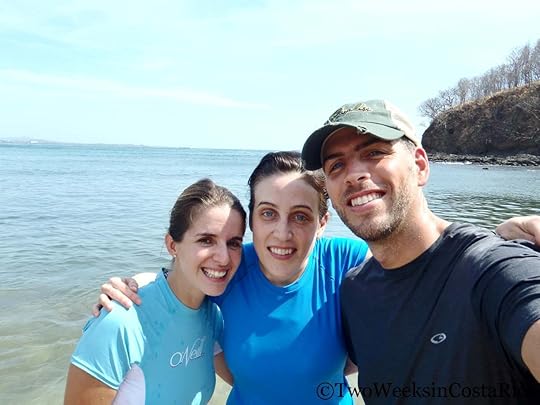
One of Matt’s awesome sisters visiting us
Overall our first year in Costa Rica was amazing and we’re really happy we made the move. Although everything isn’t perfect, we love being here and can’t imagine leaving, not right now anyway. The country’s beauty and simplicity that we fell in love with on our first visit hasn’t lost its luster. Splashing in the warm ocean or seeing a monkey cruising in a tree never seem to get old. We still have a lot to figure out and a long way to go before we’ll feel a part of the culture, but we’re only a year in and have come a long way.
That’s the recap of our first year in Costa Rica. Be sure to check out our fun one-year video too!
Have you moved abroad? What are the biggest changes you’ve experienced?
Post by: Jennifer Turnbull-Houde & Matthew Houde
July 10, 2014
Monteverde: A Forest in the Clouds
Located in the country’s northwestern mountains and straddling the Continental Divide is one of Costa Rica’s top ecotourism destinations, Monteverde. Translating to Green Mountain, this small town, originally founded by Quakers, really lives up to its name. Here, trees are covered in layers of thick moss and plants grow on top of one another due to a constant haze of misty clouds and filtered sun. This unique habitat, called the cloud forest, is home to an abundance of birds and wildlife. We recently took our second trip to Monteverde to further explore this remote destination.

Our first trip to Monteverde was back in February during Costa Rica’s dry season. At that time, conditions were cool (by Costa Rica standards) and wet, and we found ourselves shivering as we hiked along the trails of the Santa Elena Cloud Forest Reserve. This most recent visit was in late June during the country’s rainier months, so we were curious as to what we were in for. Better prepared this time with more layers, we set off down the rough dirt road from our current location near Lake Arenal.
Tip: If you’re renting a car for your visit, be sure to get a 4×4 as the road conditions are constantly changing due to heavy rains and minimal upkeep. We came across some tough, muddy areas outside of Tilaran where higher ground clearance and four-wheel drive were definitely helpful.
Monterverde and the neighboring town of Santa Elena have several cloud forest reserves with hiking trails. The most visited by far is the Monteverde Cloud Forest Reserve, where we were headed. The higher altitude Santa Elena Cloud Forest Reserve and the nearby Children’s Eternal Rainforest, the largest private reserve in Costa Rica, are two other popular options.
Arriving at the Monteverde Reserve, we noticed that the parking lot was almost full and a large tour bus had just pulled in. Luckily the reserve has eight trails and there was plenty of space to accommodate everyone. On our visit, most people seemed to opt for the main loop with the hanging bridge (Sendero Camino and Sendero Wilford Guindon), which is shorter, taking about 1.5 hours. Since we had more time, we took a longer, 3 hour route along the perimeter of the property first. We started on the Cloud Forest Trail (Sendero Bosque Nuboso) per the guidance of our bird book, which said it was one of the best places to spot the elusive Resplendant Queztal, a magnificent iridescent green and red bird with extraordinarily long tail feathers. Unfortunately, our timing wasn’t right and we weren’t able to spot one. Tip: Try to plan your visit for late March to April, which is Resplendent Quetzal breeding season and by far the easiest time to spot these shy creatures.
Although there were no Quetzals to be found, the hike was still amazing. The cloud forest is a very unique ecosystem, and at times you feel that you’re a world away. Thick moss and lichens cover every inch of tree bark and rock. Broad-leaf plants, vines, and bromeliads weigh down the lofty branches above, while colorful orchids of pink, purple, orange, and yellow splash the wall of verdant green. After walking for almost an hour through this serene landscape, we came to a lookout over the Continental Divide, the point where the Atlantic and Pacific slopes converge. Although the clouds were racing by, we managed to catch quick glimpses of the beautiful valley below.

From the viewpoint, we followed the Marshy Trail (Sendero Pantanoso) to the River Trail (Sendero El Rio). This was our favorite part of the hike because the trail ran along a steep ridge putting us at canopy level with many of the treetops, thus making it easier to see wildlife. Though it was sometimes tough to see through the thick haze, we did manage to spot a white-faced capuchin monkey, a mother and baby white-nosed coati, a gigantic snail, a small land crab, lots of interesting insects, as well as several types of birds, including wrens, warblers, and thrushes.

A white-faced monkey hiding in the thick cover
At a small waterfall on the River Trail, we took a quick break before heading back towards the ranger station to pick up the more popular trail that leads to the reserve’s famous hanging bridge. The red bridge is a quintessential part of the park and is in all of the pictures for Monteverde. We had to see it for ourselves and we’re glad we did. From high atop the swaying bridge, we had an even better view of the overflowing canopy than we did on the River Trail.

After a full morning of hiking, we were ready to explore some of the restaurants in town. The Monteverde area has an abundance of eateries to please all pallets, many using locally grown ingredients from small farms and dairies. A lot of international restaurants are popular for dinner, including Italian and fusion offerings, while cafes, bakeries, sodas (traditional Costa Rican restaurants), and even a taco spot are available for lunch. For us, the decision of where to go was easy. Earlier that morning, we had given a ride to an older gentleman who was walking to Santa Elena from the next town over. He ended up being the father of the owner of a bakery in town. His daughter’s bakery, Stella’s, did not disappoint. They had many soups, sandwiches, and other lunch offerings, but we opted to go with some of their homemade baked goods, enjoying giant cinnamon buns, empanadas, and carrot cake. Saving room for ice cream, we drove down the street to the Monteverde Cheese Factory.
The cheese factory is an icon in Monteverde and was founded by Quaker settlers in the 1950s. The Quakers not only started dairy farms but also played an important role in land conservation, helping to protect the forests surrounding their property. The factory still makes cheese to this day, as well as many other dairy products like yogurts and ice cream. Tours are available Monday – Saturday with reservations.
Fueled up with full stomachs, we started our long drive back to the lake. Driving to Monteverde as a day trip makes for a long, exhausting day. For those planning a visit, we would recommend staying for at least a couple of nights to make the drive worthwhile. Aside from hiking and eating ice cream, there are an abundance of other activities that can keep you busy. Zip-lining, horseback riding, canyoning, and four-wheeling are popular for the adventurous. If you need a break from the action, you can easily spend a full day perusing the many art galleries, shops, and exhibits. We know that next time we’re definitely making time to visit the Serpentario and the hummingbird garden.
Have you ever been to the cloud forest or seen the mysterious Resplendent Quetzal? Let us know below!
This post is part of the Sunday Traveler Series, the place to be for travel recommendations, stories, advice, and fun!

Post by: Matthew Houde and Jennifer Turnbull-Houde
July 9, 2014
Monteverde: A Forest in the Clouds

Our first trip to Monteverde was back in February during Costa Rica’s dry season. At that time, conditions were cool (by Costa Rica standards) and wet, and we found ourselves shivering as we hiked along the trails of the Santa Elena Cloud Forest Reserve. This most recent visit was in late June during the country’s rainier months, so we were curious as to what we were in for. Better prepared this time with more layers, we set off down the rough dirt road from our current location near Lake Arenal.
Tip: If you’re renting a car for your visit, be sure to get a 4x4 as the road conditions are constantly changing due to heavy rains and minimal upkeep. We came across some tough, muddy areas outside of Tilaran where higher ground clearance and four-wheel drive were definitely helpful.
Monterverde and the neighboring town of Santa Elena have several cloud forest reserves with hiking trails. The most visited by far is the Monteverde Cloud Forest Reserve, where we were headed. The higher altitude Santa Elena Cloud Forest Reserve and the nearby Children’s Eternal Rainforest, the largest private reserve in Costa Rica, are two other popular options.
Arriving at the Monteverde Reserve, we noticed that the parking lot was almost full and a large tour bus had just pulled in. Luckily the reserve has eight trails and there was plenty of space to accommodate everyone. On our visit, most people seemed to opt for the main loop with the hanging bridge (Sendero Camino and Sendero Wilford Guindon), which is shorter, taking about 1.5 hours. Since we had more time, we took a longer, 3 hour route along the perimeter of the property first. We started on the Cloud Forest Trail (Sendero Bosque Nuboso) per the guidance of our bird book, which said it was one of the best places to spot the elusive Resplendant Queztal, a magnificent iridescent green and red bird with extraordinarily long tail feathers. Unfortunately, our timing wasn’t right and we weren’t able to spot one. Tip: Try to plan your visit for late March to April, which is Resplendent Quetzal breeding season and by far the easiest time to spot these shy creatures.
Although there were no Quetzals to be found, the hike was still amazing. The cloud forest is a very unique ecosystem, and at times you feel that you’re a world away. Thick moss and lichens cover every inch of tree bark and rock. Broad-leaf plants, vines, and bromeliads weigh down the lofty branches above, while colorful orchids of pink, purple, orange, and yellow splash the wall of verdant green. After walking for almost an hour through this serene landscape, we came to a lookout over the Continental Divide, the point where the Atlantic and Pacific slopes converge. Although the clouds were racing by, we managed to catch quick glimpses of the beautiful valley below.

From the viewpoint, we followed the Marshy Trail (Sendero Pantanoso) to the River Trail (Sendero El Rio). This was our favorite part of the hike because the trail ran along a steep ridge putting us at canopy level with many of the treetops, thus making it easier to see wildlife. Though it was sometimes tough to see through the thick haze, we did manage to spot a white-faced capuchin monkey, a mother and baby white-nosed coati, a gigantic snail, a small land crab, lots of interesting insects, as well as several types of birds, including wrens, warblers, and thrushes.
 A white-faced monkey hiding in the thick cover
A white-faced monkey hiding in the thick cover At a small waterfall on the River Trail, we took a quick break before heading back towards the ranger station to pick up the more popular trail that leads to the reserve’s famous hanging bridge. The red bridge is a quintessential part of the park and is in all of the pictures for Monteverde. We had to see it for ourselves and we’re glad we did. From high atop the swaying bridge, we had an even better view of the overflowing canopy than we did on the River Trail.

After a full morning of hiking, we were ready to explore some of the restaurants in town. The Monteverde area has an abundance of eateries to please all pallets, many using locally grown ingredients from small farms and dairies. A lot of international restaurants are popular for dinner, including Italian and fusion offerings, while cafes, bakeries, sodas (traditional Costa Rican restaurants), and even a taco spot are available for lunch. For us, the decision of where to go was easy. Earlier that morning, we had given a ride to an older gentleman who was walking to Santa Elena from the next town over. He ended up being the father of the owner of a bakery in town. His daughter’s bakery, Stella’s, did not disappoint. They had many soups, sandwiches, and other lunch offerings, but we opted to go with some of their homemade baked goods, enjoying giant cinnamon buns, empanadas, and carrot cake. Saving room for ice cream, we drove down the street to the Monteverde Cheese Factory.
The cheese factory is an icon in Monteverde and was founded by Quaker settlers in the 1950s. The Quakers not only started dairy farms but also played an important role in land conservation, helping to protect the forests surrounding their property. The factory still makes cheese to this day, as well as many other dairy products like yogurts and ice cream. Tours are available Monday - Saturday with reservations.
Fueled up with full stomachs, we started our long drive back to the lake. Driving to Monteverde as a day trip makes for a long, exhausting day. For those planning a visit, we would recommend staying for at least a couple of nights to make the drive worthwhile. Aside from hiking and eating ice cream, there are an abundance of other activities that can keep you busy. Zip-lining, horseback riding, canyoning, and four-wheeling are popular for the adventurous. If you need a break from the action, you can easily spend a full day perusing the many art galleries, shops, and exhibits. We know that next time we’re definitely making time to visit the Serpentario and the hummingbird garden.
Have you ever been to the cloud forest or seen the mysterious Resplendent Quetzal? Let us know below!
You Might Also Like:
Bird Photography Tips: How to Get That Perfect Shot
Hiking in Arenal National Park
Costa Rica's Other Cloud Forest: Los Quetzales National Park
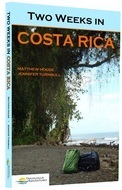
To learn more about Costa Rica, check out our book, Two Weeks in Costa Rica. It's a travelogue with a guidebook twist.
Read reviews and excerpts on Amazon.
Post by: Matthew Houde and Jennifer Turnbull-Houde
July 3, 2014
Vino de Coyol: Costa Rica’s Moonshine?
Costa Rica has its share of strange beverages, and we’ve tried a lot of them. There’s Agua de Tamarindo, a brown, sweet drink made from the tamarind fruit. If you go to a bar, you might be served Sangrita, a tomato-juice based shot that tastes to us like a BBQ-sauce Bloody Mary. And for a hot day, there’s Resbaladera, a cold rice drink made with barley, milk, cinnamon, and clove. But one we hadn’t tried yet, until now that is, was Vino de Coyol. We had seen the mysterious bottles sweating in the hot sun along the highways of Costa Rica’s Guanacaste Province, but never stopped. We wanted to learn more first.

We started with a little Internet research, discovering that the milky looking beverage is mostly popular in the small Nicoya Peninsula town of Nambi between Santa Cruz and Nicoya. It’s not actually a wine as it comes from the sap of the Coyol species of palm tree, and not grapes. When the Coyol palms are cut down, the sap ferments inside the trunk and is later extracted to create the drink. Although the beverage is said to have a very low alcohol content, there are supposedly enzymes present that can have the same effects as alcohol. Even more intriguing was the claim that a couple of glasses can put you on the floor and give you a killer hangover. Better yet still was the mention that exposure to the sun the next day can replicate the intoxication, sort of a two-for-one deal. One thing all of these stories left out, however, was what the real effects of Vino de Coyol actually were—it seemed that nobody had tried it. Being self-proclaimed wine connoisseurs, we decided to put down our box of Clos (a cheap boxed wine found in Costa Rica) and taste for ourselves. We bought a one liter vintage from a roadside table just outside of Santa Cruz for 2,000 colones (about $4). It was refrigerated and came in an old clear rum bottle with a corn cob cork. When we got home, we kept it chilled until it was time to taste. The taste actually wasn’t too bad, reminding us of something between Smarties and those fizzy natural cold remedies Airborne and Emergen-C. Not great but tolerable. It had a sweet taste and fairly smooth yet chalky body. The nose (smell for those non-connoisseurs), however, was terrible. Think vinegar and eggs. Powering through a couple of glasses, we did feel some effects but were hardly on-the-floor drunk, maybe happily buzzed at best. The next day, we woke up hangover free and ventured into the sun for a walk but either the myth of a repeat was false or the partially cloudy day prevented our second drunkenness.

Overall we’re glad we tried Vino de Coyol. We love to try new things, especially something so culturally specific to a tiny region of Costa Rica. Maybe next time, we’ll get a different vintage and experience different effects. Until then, we’ll stick to the wine made from grapes. ¡Salud!
This post is part of the Sunday Traveler Series, the place to be for travel recommendations, stories, advice, and fun!
Post by: Matthew Houde and Jennifer Turnbull-Houde
July 2, 2014
Vino de Coyol: Costa Rica's Moonshine?

We started with a little Internet research, discovering that the milky looking beverage is mostly popular in the small Nicoya Peninsula town of Nambi between Santa Cruz and Nicoya. It’s not actually a wine as it comes from the sap of the Coyol species of palm tree, and not grapes. When the Coyol palms are cut down, the sap ferments inside the trunk and is later extracted to create the drink. Although the beverage is said to have a very low alcohol content, there are supposedly enzymes present that can have the same effects as alcohol. Even more intriguing was the claim that a couple of glasses can put you on the floor and give you a killer hangover. Better yet still was the mention that exposure to the sun the next day can replicate the intoxication, sort of a two-for-one deal. One thing all of these stories left out, however, was what the real effects of Vino de Coyol actually were—it seemed that nobody had tried it. Being self-proclaimed wine connoisseurs, we decided to put down our box of Clos (a cheap boxed wine found in Costa Rica) and taste for ourselves.
We bought a one liter vintage from a roadside table just outside of Santa Cruz for 2,000 colones (about $4). It was refrigerated and came in an old clear rum bottle with a corn cob cork. When we got home, we kept it chilled until it was time to taste. The taste actually wasn’t too bad, reminding us of something between Smarties and those fizzy natural cold remedies Airborne and Emergen-C. Not great but tolerable. It had a sweet taste and fairly smooth yet chalky body. The nose (smell for those non-connoisseurs), however, was terrible. Think vinegar and eggs. Powering through a couple of glasses, we did feel some effects but were hardly on-the-floor drunk, maybe happily buzzed at best. The next day, we woke up hangover free and ventured into the sun for a walk but either the myth of a repeat was false or the partially cloudy day prevented our second drunkenness.

Overall we’re glad we tried Vino de Coyol. We love to try new things, especially something so culturally specific to a tiny region of Costa Rica. Maybe next time, we’ll get a different vintage and experience different effects. Until then, we’ll stick to the wine made from grapes. ¡Salud!
You Might Also Like:
Road Trip to Mal Pais
Tamarindo: Where Paradise Meets Convenience
Caipirinha Recipe
Post by: Matthew Houde and Jennifer Turnbull-Houde
June 26, 2014
Road Trip to Mal Pais
For months we had been meaning to make the trek to the beach towns of Mal Pais and Santa Teresa. Known for consistent surf, pristine jungle, and a chill vibe, Mal Pais has attracted quite a following, even among celebrities. If it’s good enough for Tom Brady, Gisele Bündchen, Leonardo DiCaprio, and Matthew McConaughey, what was stopping us, right? Our biggest deterrent was that Mal Pais is located in a remote corner of the Nicoya Peninsula, far from every place we have visited during our travels. The roads were also said to be very bad, making us weary to take our own car. So, finally, with a rental car and a packed cooler, we decided to take a road trip and see for ourselves what makes Mal Pais so special.

Orientation
Mal Pais and Santa Teresa, often called Mal Pais in short, are located in the southwestern Nicoya Peninsula, tucked between the warm Pacific Ocean and steep, lush hills. The fishing village of Mal Pais extends to the border of Cabo Blanco Nature Reserve on the very southern tip of the Nicoya. Santa Teresa, just to the north, is home to the majority of the area’s hotels, restaurants, bars, and surf shops. There’s only one main road between the two towns, making it easy to get around.
Directions to the area are somewhat confusing so we give comprehensive ones later in this post.
Activities
Surfing is by far the biggest attraction in Mal Pais, and several beaches like Playa Santa Teresa and Playa Carmen offer consistent swells. If you’re not looking to surf, there are plenty of other things to do like yoga, zip-lining, stand-up paddleboarding, and horseback riding. The nearby Cabo Blanco Nature Reserve offers hiking and a chance to see wildlife like howler monkeys, white-faced capuchin monkeys, sloths, and coatis as well as many birds. The town of Montezuma, which has some spectacular waterfalls, is also just a short drive away.
Tip: We got the insider scoop on the area from our friends over at Pollo Pass. Per Macho Pollo’s recommendation, we headed to the more remote beach of Playa Hermosa just north of town for swimming and sun. Apparently this is the beach the celebs frequent and we can see why—it did not disappoint.
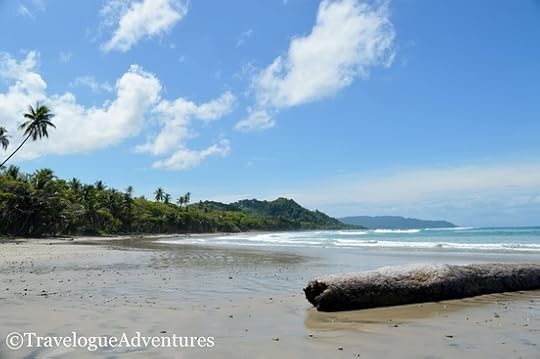
The serene Playa Hermosa
Restaurants
People from all over the world have made the move to Mal Pais and brought with them a variety of cuisine. You can get everything from Indian and Mexican food to sushi, pizza, and all-American hamburgers and hotdogs. Typical Costa Rican fare can also be found and, of course, there’s plenty of the freshest seafood. Overwhelmed by the choices, we followed Pollo Pass’ recommendations on this one too and loved the Argentinian-influenced Casa del Mar, the French-inspired Couleur Café, and the rice and fish bowls at Product C.
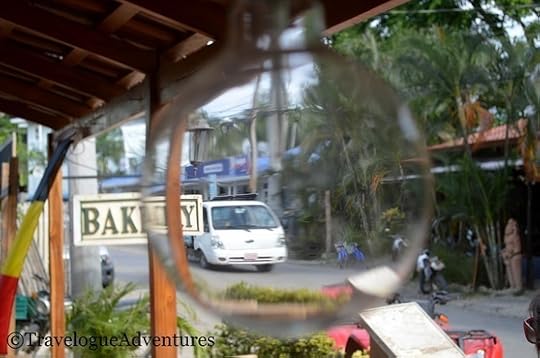
Directions
The roads on the southern Nicoya Peninsula are known to be rough but, overall, they weren’t as bad as we had expected. The best way to get to Mal Pais is to take Route 160 along the coast. The drive is very scenic, with sweeping views of the bay and surrounding islands. It’s mostly paved but has some long stretches of gravel as well.
Tip: Opt for a vehicle with 4-wheel drive. Once you get onto Route 160, parts of the road are hilly with loose gravel, especially after the turnoff from Cobano. It will also be handy once you get to town. Although some of the main road in Santa Teresa was recently paved, it’s still rough dirt for the most part.
From Liberia- Head south on Route 21 and continue through the towns of Belen, Santa Cruz, and Nicoya. The road eventually changes from Route 21 to Route 160 in the town of Naranjo. In Paquera, take a right at the stop sign in town (towards the Mega Super grocery store) to stay on 160. This turn is not marked. In the town of Cobano, take a left and follow signs to Mal Pais/Santa Teresa.
From Nosara or Samara- Take Route 150 to Nicoya and connect with Route 21 south, then follow the directions above. There is also a coastal route south of Samara, though most advise against this as you have to drive on the beach and there are multiple river crossings.
From San Jose- Take Route 27 to Route 23 and then Route 17 to the Puntarenas ferry landing. Cross the bay on the ferry to Paquera. From Paquera, take Route 621 (the main road) to the center of town and continue straight onto Route 160 (passing the Mega Super grocery store, left side). In the town of Cobano, take a left and follow signs to Mal Pais/Santa Teresa.
* * *
Our road trip to Mal Pais and Santa Teresa definitely did not disappoint. Now that we’ve finally visited, we can see why so many people fall in love. The area still feels pristine, with plenty of lush jungle, and has maintained a small-town feel despite the many businesses catering to tourists. There’s also something about a destination being a little hard to get to that is appealing in its own way. Along the rough roads, you’re forced to go slower, taking in the beautiful views and quaint towns, instead of speeding past them. And when you finally do arrive, you feel like you’re in on a secret that few have taken the time to discover.
Post by: Jennifer Turnbull-Houde & Matthew Houde
June 25, 2014
Road Trip to Mal Pais
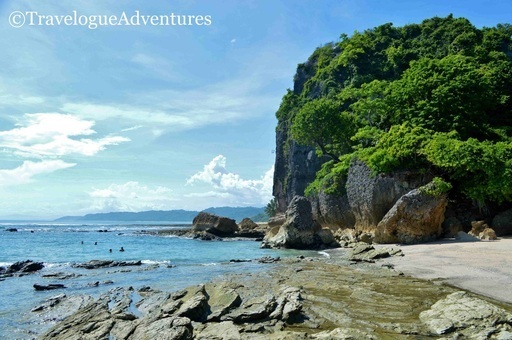
Orientation
Mal Pais and Santa Teresa, often called Mal Pais in short, are located in the southwestern Nicoya Peninsula, tucked between the warm Pacific Ocean and steep, lush hills. The fishing village of Mal Pais extends to the border of Cabo Blanco Nature Reserve on the very southern tip of the Nicoya. Santa Teresa, just to the north, is home to the majority of the area’s hotels, restaurants, bars, and surf shops. There’s only one main road between the two towns, making it easy to get around.
Directions to the area are somewhat confusing so we give comprehensive ones later in this post.
Activities
Surfing is by far the biggest attraction in Mal Pais, and several beaches like Playa Santa Teresa and Playa Carmen offer consistent swells. If you’re not looking to surf, there are plenty of other things to do like yoga, zip-lining, stand-up paddleboarding, and horseback riding. The nearby Cabo Blanco Nature Reserve offers hiking and a chance to see wildlife like howler monkeys, white-faced capuchin monkeys, sloths, and coatis as well as many birds. The town of Montezuma, which has some spectacular waterfalls, is also just a short drive away.
Tip: We got the insider scoop on the area from our friends over at Pollo Pass. Per Macho Pollo’s recommendation, we headed to the more remote beach of Playa Hermosa just north of town for swimming and sun. Apparently this is the beach the celebs frequent and we can see why—it did not disappoint.
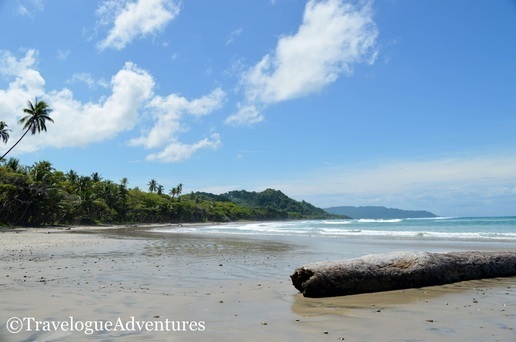 The serene Playa Hermosa
The serene Playa Hermosa Restaurants
People from all over the world have made the move to Mal Pais and brought with them a variety of cuisine. You can get everything from Indian and Mexican food to sushi, pizza, and all-American hamburgers and hotdogs. Typical Costa Rican fare can also be found and, of course, there’s plenty of the freshest seafood. Overwhelmed by the choices, we followed Pollo Pass’ recommendations on this one too and loved the Argentinian-influenced Casa del Mar, French Couleur Café, and the rice and fish bowls at Product C.

Directions
The roads on the southern Nicoya Peninsula are known to be rough but, overall, they weren’t as bad as we had expected. The best way to get to Mal Pais is to take Route 160 along the coast. The drive is very scenic, with sweeping views of the bay and surrounding islands. It’s mostly paved but has some long stretches of gravel as well.
Tip: Opt for a vehicle with 4-wheel drive. Once you get onto Route 160, parts of the road are hilly with loose gravel, especially after the turnoff from Cobano. It will also be handy once you get to town. Although some of the main road in Santa Teresa was recently paved, it’s still rough dirt for the most part.
From Liberia- Head south on Route 21 and continue through the towns of Belen, Santa Cruz, and Nicoya. The road eventually changes from Route 21 to Route 160 in the town of Naranjo. In Paquera, take a right at the stop sign in town (towards the Mega Super grocery store) to stay on 160. This turn is not marked. In the town of Cobano, take a left and follow signs to Mal Pais/Santa Teresa.
From Nosara or Samara- Take Route 150 to Nicoya and connect with Route 21 south, then follow the directions above. There is also a coastal route south of Samara, though most advise against this as you have to drive on the beach and there are multiple river crossings.
From San Jose- Take Route 27 to Route 23 and then Route 17 to the Puntarenas ferry landing. Cross the bay on the ferry to Paquera. From Paquera, take Route 621 (the main road) to the center of town and continue straight onto Route 160 (passing the Mega Super grocery store, left side). In the town of Cobano, take a left and follow signs to Mal Pais/Santa Teresa.
* * * Our road trip to Mal Pais and Santa Teresa definitely did not disappoint. Now that we’ve finally visited, we can see why so many people fall in love. The area still feels pristine, with plenty of lush jungle, and has maintained a small-town feel despite the many businesses catering to tourists. There’s also something about a destination being a little hard to get to that is appealing in its own way. Along the rough roads, you’re forced to go slower, taking in the beautiful views and quaint towns, instead of speeding past them. And when you finally do arrive, you feel like you’re in on a secret that few have taken the time to discover.
You Might Also Like:
Cabo Blanco Nature Reserve
Tamarindo: Where Paradise Meets Convenience
Puerto Viejo: Caribbean Cool in Costa Rica

To learn more about Costa Rica, check out our book, Two Weeks in Costa Rica. It's a travelogue with a guidebook twist.
Read reviews and excerpts on Amazon. Post by: Jennifer Turnbull-Houde & Matthew Houde
June 19, 2014
The Pure Life Pace: A Horseback Tour in Nosara
Nosara has loads of adrenalin-pumping adventure activities from touring the mountains in a military-grade TOMCAR to flying through the rainforest on one of the world’s longest zip-lines. But, remember, part of visiting Costa Rica is enjoying la pura vida (the pure life), slowing down and taking in the beautiful natural surrounds. Below we share one of the best ways to do just that—horseback riding.

We started our morning at the Boca, the mouth of the river where the Rio Nosara and the Rio Montana converge and spill into the Pacific. Our guide was Manuel, a Tico who has been caring for the horses at Boca Nosara Tours for over ten years. Matt and I were both horseback-riding amateurs, having done it only once before, but Manuel and the team put us at ease, giving us instructions and making sure we were comfortable handling our horses before we left.
Atop our beautiful horses, Palomo and Zafiro, we first headed into the nature reserve not far from the property. Thick mangroves filled the wetlands beside the trail. Howler monkeys groaned from high up in the canopy. Colorful birds like Motmots, Violaceous Trogans, and Long-tailed Manakins darted past. Manuel taught us all about the wildlife and some of the native trees too, like the grand Guanacaste tree, which drops pods with beautiful brown seeds. We passed a point on the river which was said to often have crocodiles but didn’t spot any.
A dirt road led us back into the thick jungle, this time closer to the beach. The rainy season had just begun and the plants were turning from dry and brown to vibrant green. The horses, used to eating hay, were grabbing for the tender greens like a kid grabs for candy. We continued on, Manuel blazing through the jungle with his machete, cutting back any overgrown plants that might be in our way.
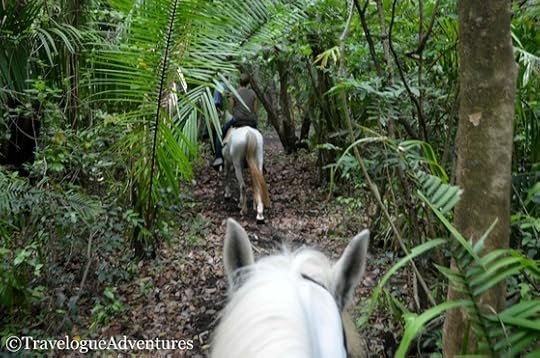
Soon we were on the beach. Playa Pelada was all but deserted. It was a calm day and the ocean was a picturesque aquamarine. We passed by the famous blowhole on the rocks just as a wave came thundering in, a little girl and her parents getting sprayed by the mist. As we started rounding the corner, Manuel asked if we would like to gallop. We said we would and the horses were off, bounding through the fluffy white sand.
We soon entered the jungle again and climbed the hill to a lookout. In front of us was a stunning view of the cove below. Just when we thought Costa Rica couldn’t amaze us anymore with its natural beauty, it proved us wrong once again.
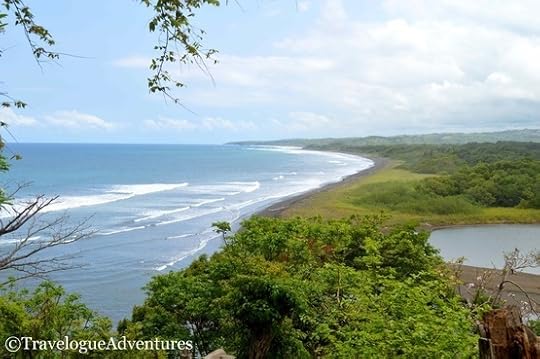
Horseback riding was of our favorite activities while living in Nosara. The ride was relaxing and exciting at the same time, and we were able to see so much in just a couple of hours. There are lots of tour companies in the area but we loved our ride with Boca Nosara Tours.
So if you’re looking to take a break from the heart-pumping activities that Costa Rica is famous for, be sure to add a horseback tour to your list. Whether it’s in Nosara or one of the many other towns offering tours, we’re sure you’ll love the laid-back pace, connection with nature, and most of all, chance to experience la pura vida.
Post by: Jennifer Turnbull-Houde & Matthew Houde





